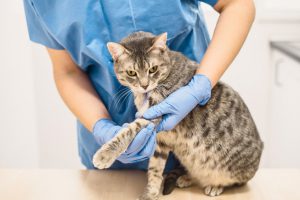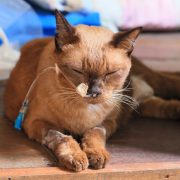Frunevetmab, a felinized anti-nerve growth factor monoclonal antibody, for the treatment of pain from osteoarthritis in cats
Frunevetmab, a felinized anti-nerve growth factor monoclonal antibody, for the treatment of pain from osteoarthritis in cats.

Open access
In our edition of: Feb 2022
In our categories of: small animals
our summary:
Gruen, M.E. et al (2021) Frunevetmab, a felinized anti-nerve growth factor monoclonal antibody, for the treatment of pain from osteoarthritis in cats. Journal of Veterinary Internal Medicine, 35 (6), pp2752-2762 https://doi.org/10.1111/jvim.16291
The aim of this randomised, placebo-controlled, double-blind study was to evaluate the efficacy of frunevetmab, a felinized anti-nerve growth factor monoclonal antibody in cats with naturally occurring osteoarthritic (OA) pain. The study was funded by Zoetis, manufacturers of frunevetmab, four of the six authors are employed by Zoetis and the other two have worked as paid consultants.
275 cats were enrolled from 21 practices across the United States and randomised, at a ratio of 2:1 frunevetmab:placebo, into two groups. All cats received three injections at 28-day intervals, group one received frunevetmab (1.0 to 2.8 mg/kg; nominal dose of 1.0 mg/kg, n= 182) and group two received the placebo (n=93). Both owners and investigators were blinded to the treatment allocation. Cats were examined at the veterinary clinic on days 0, 28, 56 and 84, with the vet performing a physical and orthopaedic assessment. Owners visited the clinic to complete clinical metrology instruments on days 0, 28, 56 and 84, they also reported their cat’s status by phone on days 7 and 112.
The client specific outcome measure showed a significantly greater percentage of cats in the frunevetmab group achieved treatment success at the primary efficacy endpoint, day 56 (75.91%), compared to placebo (64.65%), and on day 28, frunevetmab (66.70%) vs placebo (52.06%). On day 84, cats in the frunevetmab-treated group had a numerically higher success rate, but this was not statistically significant.
Results from the veterinary orthopaedic examinations showed the overall treatment effect on total pain scores was significant, with lower scores at all time points in the frunevetmab group, which were statistically significant at days 56 and 84.
Adverse events (AEs) were similar for both groups; the most frequently reported AEs were digestive tract disorders, which included emesis and diarrhoea. When taken collectively, ‘skin disorders’ occurred significantly more frequently in the treatment group compared to placebo.
Limitations of the study include the lack of detail on the veterinary assessed outcome measures and the possibility of expectation bias from owners and veterinary surgeons based on the positive results from an earlier pilot proof-of-concept study. It is also of note that there was a high apparent placebo effect in the client specific outcome measures, which should be considered when interpreting the results of the study.
This study provides some evidence for the effectiveness and safety of frunevetmab for the alleviation of pain associated with osteoarthritis in cats. It will be of interest to veterinary surgeons advising clients on the available therapies for their cats. Further studies on this new product and comparisons with currently available treatments are required.
This study provides additional evidence to the following paper which was included in the August 2021 edition of inFOCUS.
Image copyright attribute: vonschonertagen
Join the discussion
We encourage discussion on all material highlighted in each edition of inFOCUS. Use the button below to join the conversation on Twitter and include your comment in the feed for this issue.








Leave a Reply
Want to join the discussion?Feel free to contribute!